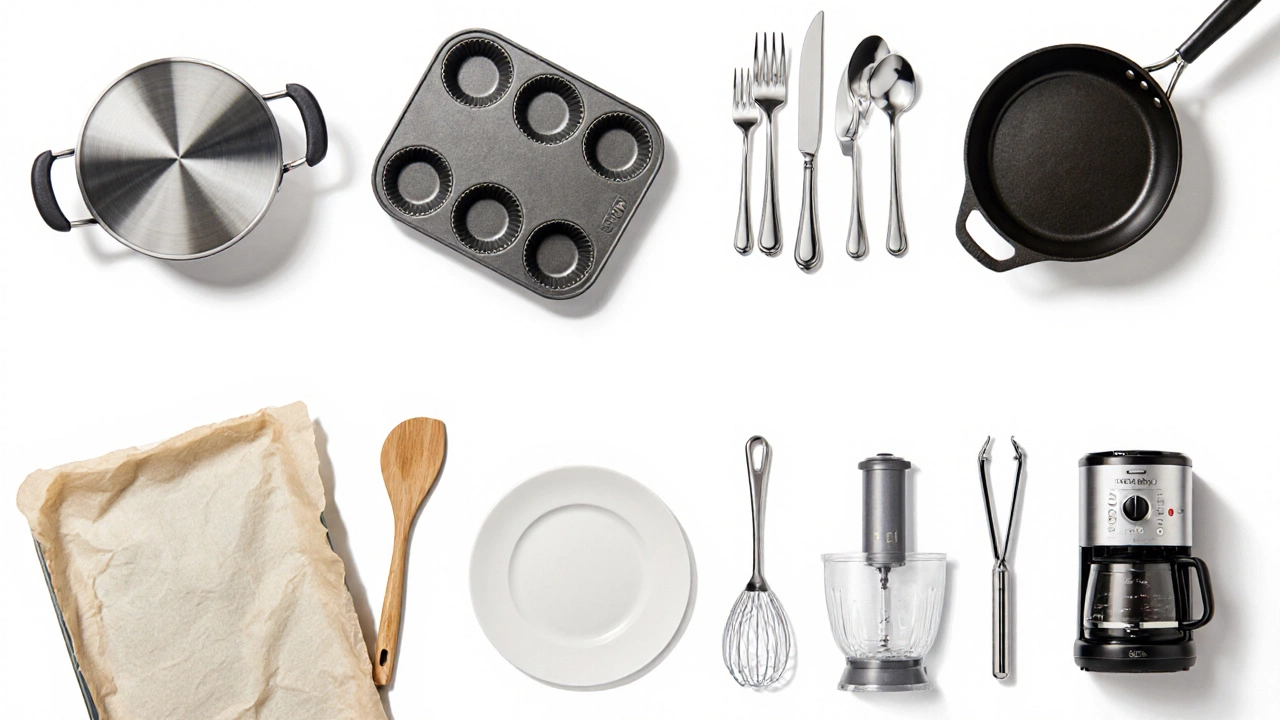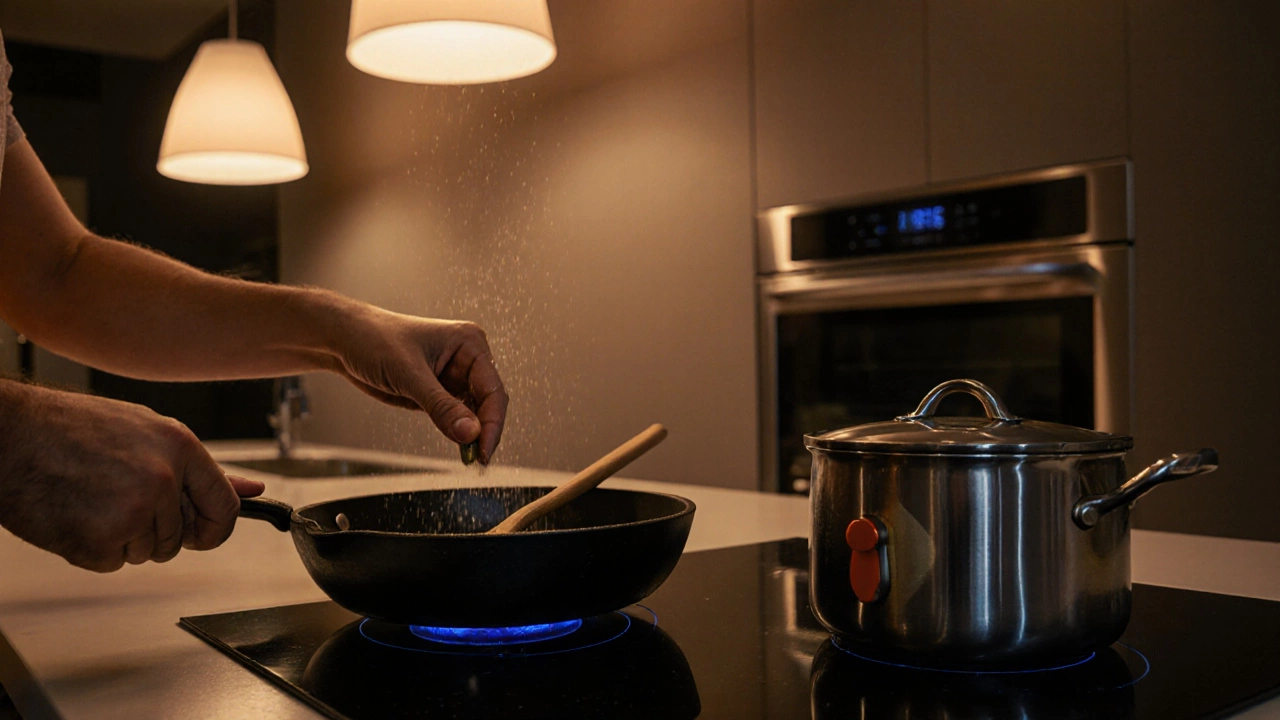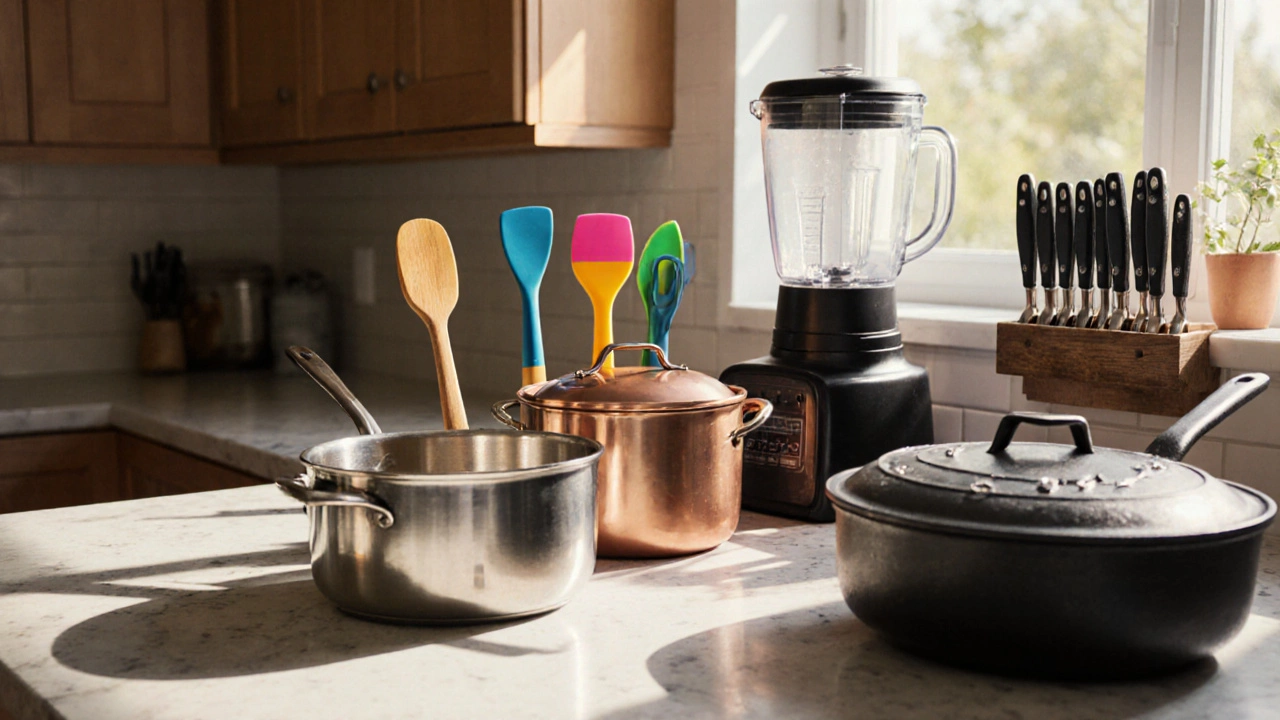Kitchenware Material Selector
Find the perfect kitchenware material for your cooking style and budget. Answer a few questions to get personalized recommendations.
Top Match
Alternative Options
When you hear the word kitchenware, you might picture a shiny set of pans or a row of colorful knives. In reality, the term covers a far wider range of items that help you prep, cook, and serve food. Understanding what kitchenware really means can make shopping easier, keep you from buying duplicate tools, and even improve the way you cook.
Defining Kitchenware
Kitchenware is the collective name for all tools, utensils, cookware, bakeware and accessories used in food preparation, cooking, and serving. It includes everything from a simple wooden spoon to a high‑tech immersion blender. The scope is so broad that it overlaps with other home‑related categories like tableware and small appliances, but the core idea is any item that helps you work in the kitchen.
Major Types of Kitchenware
Breaking kitchenware into sub‑categories helps you spot gaps in your collection and decide what to buy next.
- Cookware is any pot, pan, or skillet designed for cooking on the stovetop or in the oven. Think saucepans, frying pans, and stock pots.
- Bakeware is specialised pans, trays and dishes used for baking cakes, breads, pastries and casseroles. Common pieces include cake tins, muffin pans and baking sheets.
- Cutlery is knives, forks and spoons primarily used at the dining table. While many people store cutlery with other kitchen tools, its design focuses on eating rather than cooking.
- Utensils is hand‑held tools such as spatulas, ladles, tongs and whisks that assist with mixing, turning and serving. These are the workhorses of everyday cooking.
- Small Appliances is electric devices like blenders, food processors, toaster ovens and coffee makers that automate specific kitchen tasks. They blur the line between cookware and gadgetry.
- Tableware is plates, bowls, glasses and serving platters used to present and consume food. Though often listed separately, it forms part of a complete kitchenware ecosystem.

Materials That Shape Kitchenware
Every piece of kitchenware is built from a material that influences performance, durability and price. Here are the most common choices:
- Stainless steel: Resistant to rust, easy to clean, and works well on most heat sources. Ideal for pots, pans and many utensils.
- Cast iron: Heavy but excellent at retaining heat, perfect for searing and slow‑cooking. Requires seasoning to maintain a non‑stick surface.
- Aluminium: Lightweight and conducts heat quickly. Often anodised or coated to prevent reactions with acidic foods.
- Copper: Superior heat conductivity; popular among professional chefs for precise temperature control. Usually lined with tin or stainless steel to avoid metal taste.
- Non‑stick coatings: Teflon‑type surfaces reduce sticking and cleaning time, but they can degrade at high temperatures.
- Silicone: Flexible, heat‑resistant up to ~230°C, and ideal for spatulas, baking mats and muffin liners.
- Wood and bamboo: Gentle on cookware, naturally anti‑bacterial, and great for spoons, spatulas and cutting boards.
A Brief History of Kitchenware
From clay pots in ancient Mesopotamia to 21st‑century smart ovens, kitchenware has evolved alongside human civilization. Early societies used stone and fire‑hardened ceramics to bake bread. The Romans introduced metal cookware, while the Industrial Revolution mass‑produced steel pans that made cooking more efficient. In the 1950s, non‑stick coatings hit the market, and today, IoT‑enabled devices let you control a pressure cooker from your phone.
How to Choose the Right Kitchenware for Your Needs
If you’re starting from scratch or simply looking to upgrade, follow these practical steps.
- Identify your cooking style. Do you stir‑fry, braise, bake, or all of the above? A stovetop‑centric cook will prioritise sturdy pans, while a baker will need a range of bakeware.
- Set a budget. High‑end copper cookware can exceed £500 per piece, whereas decent stainless steel sets range £80‑£150.
- Consider material trade‑offs. If you need rapid heating for pancakes, aluminium is ideal. For slow‑cook stews, cast iron excels.
- Check compatibility with your cooktop. Induction surfaces require magnetic‑based cookware (typically stainless steel or cast iron).
- Look for ergonomic design. Handles that stay cool, balanced weight distribution and easy‑grip knobs reduce fatigue.
- Read warranty details. Many reputable brands offer a lifetime warranty on core cookware pieces.

Maintenance Tips to Extend the Life of Your Kitchenware
Proper care can keep your tools performing like new for years.
- Season cast iron. After each use, wipe with a thin oil layer and heat briefly to lock in protection.
- Avoid abrasive cleaners on non‑stick surfaces. Soft sponges and mild dish soap are enough.
- Dry metal items promptly. Prevent water spots and rust by towel‑drying or air‑drying on a rack.
- Use wooden or silicone utensils on non‑stick pans. This avoids scratching the coating.
- Store pots and pans with protective liners. Placing a paper towel between stacked items reduces dents.
Quick Comparison: Cookware vs. Bakeware
| Feature | Cookware | Bakeware |
|---|---|---|
| Typical Materials | Stainless steel, cast iron, aluminium, copper | Aluminium, silicone, insulated glass, non‑stick coated metal |
| Common Uses | Sautéing, boiling, frying, simmering | Baking cakes, breads, roasts, casseroles |
| Heat Source | Stovetop, oven, induction | Oven, occasional grill |
| Design Focus | Even heat distribution, handle comfort | Even baking surface, releaseability |
| Care Tips | Seasoning for cast iron, avoid sudden temperature shocks | Line with parchment, avoid cutting directly on the surface |
Frequently Asked Questions
What items are considered kitchenware?
Kitchenware includes cookware, bakeware, cutlery, utensils, small appliances and tableware-basically anything you use to prepare, cook or serve food.
Is a blender part of kitchenware?
Yes. A blender is a small appliance that automates a specific kitchen task, so it falls under the kitchenware umbrella.
Can I use metal utensils on non‑stick pans?
It’s best to stick with wooden, silicone or nylon tools. Metal can easily scratch the non‑stick coating, shortening the pan’s lifespan.
How do I know if my cookware is induction‑compatible?
Look for a magnet‑test: if a magnet sticks to the base, the piece will work on an induction cooktop. Stainless steel and cast iron usually pass; aluminium alone does not.
What’s the difference between cookware and bakeware?
Cookware is built for direct heat on stovetops or quick oven bursts, focusing on heat conduction. Bakeware is designed for even, sustained oven heat, often featuring non‑stick surfaces or silicone for release.

